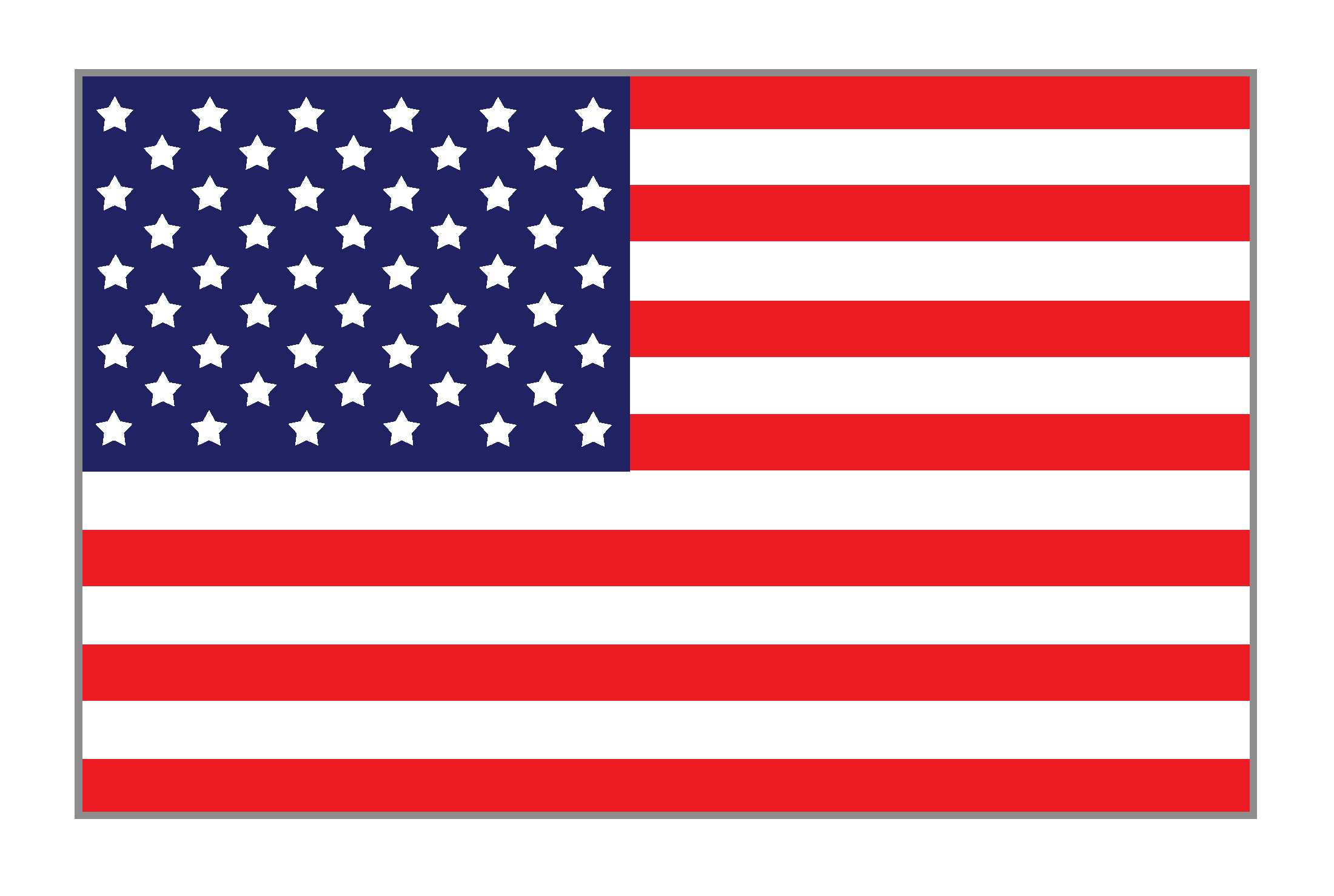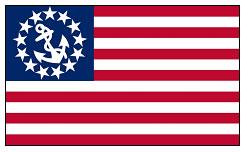Fly It Proudly
Flags are colorful, festive and informative. Every boat owner should be familiar with the customs that apply to all the types of flags typically flown.
Unlike buildings and houses, boats have a limited number of places to fly their flags, and so you may need to pick and choose the flags you fly. There will typically be three flags displayed: one announcing nationality, one announcing club affiliation and one announcing status (private signal or club officer’s flag).
National Ensign (50-Star US flag)

The familiar 50 star “stars and stripes” flag is also known as the national ensign. It is the most important flag on board and identifies national character. Character is determined by registration, which may differ from that of the owner. This is especially important abroad and on the high seas.
A ship’s national ensign is immediately recognizable because it flies farthest aft (the place of honor), but not necessarily from the highest point in the rig. With the possible exception of battle flags, it should be the vessel’s largest flag.
Normally the national ensign is flown from a staff on the stern. No other flag may be flown from this position. However, it is also permissible on a sailboat to fly it from the leech of the aft-most sail about two-thirds of the way up or from the peak of the gaff on a gaff-rigged vessel. Sport fishing boats, which cannot fly the ensign from the stern when underway because of interference with fishing lines, fly the ensign from the aft end of the tuna tower on the centerline and often leave it there when not moving. When not moving, the national ensign is only flown from the stern staff on all vessels.
Here are some tips for flying the American flag correctly:
Do: Choose the right size!
Don’t: Fly a flag that is too big!
Do: Fly it during daylight hours ONLY!
Don’t: Fly the American flag from the:
- Top of the mast
- Spreader flag halyard
- Bow staff
- Fishing outriggers

US Yacht Ensign

American yachts may also fly a flag called the Yacht Ensign. This flag is similar to the U.S. Ensign except a circle of 13 stars surrounding an anchor replaces the 50 stars. It was established by Congress in 1848 to identify yachts that do not have to clear customs when entering ports and licensed yachts were required to fly it. The law has changed so that the yacht ensign is now an option for any American recreational boats. Either the national ensign or yacht ensign may be flown by US yachts, but not simultaneously. When a US yacht sails in international waters, the 50-star flag must be flown and not the yacht ensign.
Club Burgee

Yacht and sailing clubs have flags to distinguish them called a burgee. Most yacht club burgees are pennant (three sided) shaped like the SHYC burgee, but a few clubs use swallow-tailed flags and a few use rectangular flags. Our club has a collection of burgees from many other clubs that are displayed in the Clubhouse as you are entering the bar area.
Flying the burgee is an important part of belonging to a yacht club and a vessel owned by a member of SHYC should fly our burgee with pride. Our burgee has appeared in its present form since ????
The burgee is flown from the bow staff on a powerboat, while most sailboats fly the burgee from the starboard spreader. The traditional position at the top of the mast is no longer used because of interference with wind sensors and antennas. Normally a vessel displays only one burgee at a time. Exceptions are made for opening day and other special occasions when owners will string together all burgees of clubs to which they belong, if more than one. The SHYC burgee should be at the top of the string for SHYC functions.
Officers Flags
The yacht ensign’s circle of 13 stars surrounding an anchor forms the basis for the officer flags used by SHYC and many other yacht clubs for the commodore, vice commodore and rear commodore, with the background being blue, red and white respectively. Other officers such as secretary, treasurer, and past commodore, etc., have their own flags. SHYC Past Commodores also have a unique swallow tailed flag to fly, which is the Past Commodore’s flag from 1907. On sailboats the officer flag is flown immediately below the burgee. On powerboats, the officer flag is flown from the mast, with the club burgee keeping its place flown at the staff. Officer flags are flown only when the officer is aboard.
Dressing Ship
On national holidays, boat christenings, marine parades and other special occasions yachts often “dress ship” with a rainbow of International Code of Signal flags. The sequence is based on a harmonious color scheme and has no meaning in terms of letters or numerals. Flags are flown beginning with “A” at the forward waterline, over the stem and the top of the mast(s), to the stern and finally to the waterline aft. The flags discussed above are flown in their usual places.
The recommended sequence is: AB2, UJ1, KE3, GH6, IV5, FL4, DM7, PO 3rd Repeater, RN 1st Repeater, ST Zero, CX9, WQ8, ZY 2nd Repeater.
Important: If you don’t have a set of signal flags, sets of decorative pennants are available at modest cost.
Power boats too! This is not just for sailboats.
Private Signals
One of the oldest traditions in yachting is that of the “Private Signal.” A private signal is a unique flag that communicates the presence of a specific individual or family on a boat. They are personal flags, or logos, similar to family crests. The tradition of the private pennant signal, or “house flag,” currently used dates back to the 18th and 19th century when the sailing ship lines were at their peak. Traditionally, a private signal referred to the owner or their family, but some private signals refer to the boat.
The private signal is flown from the starboard spreader flag halyard on both power and sail boats. If a powerboat doesn't have such a halyard, the private signal may be flown at the top of an antenna on the starboard side. Boats without a mast may fly the private signal from the bow staff in place of the burgee.
If you would like to have a private signal, here are some tips for good design:
Shape – You may use any shape, but three types are used primarily for private signals:
Non-tapering swallowtail, swallowtail and rectangular. Most clubs use the pennant shape (e.g., the HYC burgee) so the pennant shape is not recommended for private signals.
Keep it Simple – A design without small details is easiest to see from a distance. It is also easiest to reproduce, which is important when you have your flag reproduced on clothing, dishware, etc. Traditionally, initials are not used.
Consider Mirror Image Designs should look nice from both the front and back. Thus, words don’t usually work well since they will read backwards on one side. Double-sided flags can be made but are much more expensive.
Few Colors – flags limited to 2 or 3 colors look better. They are easier to see from a distance and easier to reproduce.
Color Choice – Basic vivid colors work best. Use contrasting colors, light and dark. Colors that are similar, such as blue and green, will be harder to distinguish from a distance.
Other Flags
Courtesy flags: When a US vessel is in the waters of a foreign country, it is expected that she will fly the host country’s national flag from the starboard spreader on a sailboat or from the starboard spreader of a powerboat with a mast, or the bow staff of a mast- less powerboat. This is especially important for boats going to Mexican or Caribbean ports. Note that the Bahamas, The British Virgin Islands, the Cayman Islands and the United Kingdom each have red ensign versions of their flag that are the correct flags to be used for this purpose.
Fish or Prize Flags: Fishing boats often fly flags denoting their catch. Flags denoting marlin, wahoo, sailfish and other species are available from marine suppliers. They are flown from the port outrigger or spreader, and are flown upside down if the catch was released.
Blue Gavel Flag: Past commodores of HYC who have been inducted into the International order of the Blue Gavel may fly the IOBG flag. When flown it replaces the past commodore’s flag.
Reference: For history and more detailed information, see Yachting Customs and Courtesies by J.A. Tringali.

